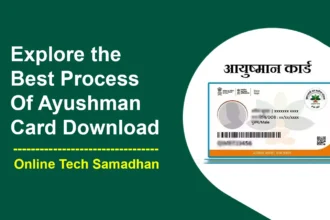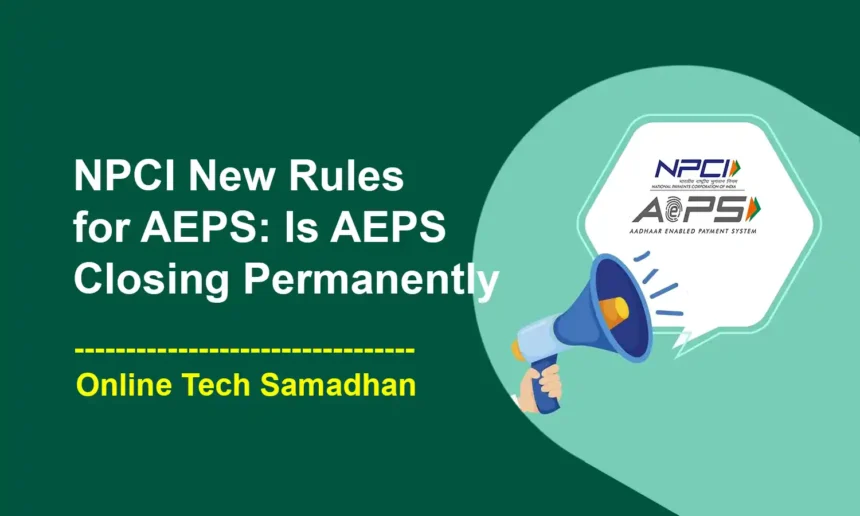Secure Your Transactions: NPCI New Rules for AEPS Transaction
Have there been rumors that AEPS will close its doors forever? Let’s have a discussion. Instead of completely discontinuing AEPS, the National Payments Corporation of India (NPCI) has introduced some new guidelines. This essay will help you comprehend the new NPCI regulations to figure out if AEPS will continue to exist or collapse. We’ll talk about Is AEPS Closing Down Forever and What is the NPCI New Rules for AEPS. Therefore, there’s no need to worry about AEPS getting Closed forever.

Make Sure About the Shutdown Rumors
Let’s clear up the talk about AEPS possibly going to shut down. Some news updates are saying AEPS is Closing Down Forever, but the NPCI, the ones in charge, says it’s not true. Now, why does this matter? Well, AEPS is a big help, especially for folks in villages. Think about it: in places where regular banks aren’t so close, AEPS is like a superhero, making sure people can do important money stuff.
If AEPS were to shut down, it would make things tough for these folks. Imagine no quick way to get money or do transactions. It’s not just a tech thing; it’s about making life harder for people, especially those in villages who need AEPS for their everyday money things.
You May Love To Read
NPCI New Rules for AEPS 2024
1. All AEPS Agents are required to register and maintain transactions History.
2. If an AEPS Agent’s biometric authentication fails three times consecutively on the AEPS Application, their ID will be blocked for 24 hours.
3. In case of the first biometric authentication failure, the agent should change the finger and retry.
4. If there are repeated biometric authentication failures for the AEPS Agent or Customer, the biometric device will become INACTIVE or BLOCKED.
5. Starting now, before every transaction, AEPS Agents must provide their fingerprint or authentication. For example, during withdrawals, the VLE (Village Level Entrepreneur) should first provide their fingerprint, followed by the customer providing theirs. Two-factor authentication using fingerprints will be valid for three minutes.
6. Two-factor authentication will be done using devices such as Morpho, Mantra, or Statrek. However, the same device should be used throughout the day, and using the same device across different systems is not allowed. Multi-use options will be shown only if the device used for login is the same as the one used for subsequent actions.
7. Avoid applying excessive pressure or too light a touch on the fingers, as it may affect the accuracy of biometric verification. The device may be blocked by UIDAI for such actions.
8. AEPS Agents should use different fingers during login and transactions to ensure proper authentication.
You May Love To Read
9. Do not use the same biometric device for different AEPS systems or use it on multiple mobiles or computers. Also, avoid using the same ID for multiple devices.
10. If an ID remains inactive for three consecutive months, it will be deactivated. This rule applies to any AEPS ID from any company, as per NPCI regulations.
11. Transactions of denominations 1010, 1020, and 1050 are not allowed. Attempting such transactions may result in the blocking of your ID.
12. Every AEPS Agent should provide Micro ATM or ATM services alongside AEPS for customer convenience.
NPCI New Rules for AEPS: Making AEPS Better and Safer
To make AEPS even better, the NPCI is bringing in some NPCI New Rules for AEPS.
1. Linking Aadhaar is a Must
Starting September 30, 2023, everyone needs to link their Aadhaar to AEPS. It’s like adding an extra lock to keep your money safe. Imagine it as having a special key just for you, so no one else can access your account without your permission.
2. Limits on Taking Out Money
Now, there are some NPCI New Rules for AEPS on how much money you can take out. For regular transactions, it’s ₹2,000 each time and ₹10,000 per day. If you’re doing mini ATM stuff, like getting cash in smaller amounts, it’s ₹5,000 per go and ₹25,000 per day. This helps in keeping things secure and controlled, preventing any unwanted surprises.
3. Using Your Fingers for Safety
NPCI wants everyone to use their fingerprints for transactions. It’s like having your secret code to make sure it’s you. Think of it as your unique signature that no one else can replicate. This adds an extra layer of protection, making sure only you can access and manage your money.
4. Making AEPS Work Everywhere
They are also trying to make AEPS work better with different companies, so you can use it in more places. Imagine if your favorite payment app, grocery store, or even a local shop accepts AEPS seamlessly. This makes your life easier as you can use the same system you trust in various locations, making financial transactions more convenient.
Top AEPS Services Provider Company
DigiPay: DigiPay is a popular AEPS service provider, making digital payments and banking services easy. DigiPay stands out for its user-friendly design, helping people access various banking services with convenience and efficiency.
Spice Money: Spice Money is a big name in AEPS, offering a bunch of financial services, especially Aadhaar-enabled transactions. With agents spread out, Spice Money ensures safe and easy digital transactions for users everywhere.
Airtel Payment Bank: Airtel Payment Bank is a major player in AEPS, blending telecom services with financial solutions. People can use Airtel Payment Bank for AEPS transactions, enjoying a reliable and all-in-one platform for their banking needs.
NSDL Payment Bank: NSDL Payment Bank is known for its trustworthy AEPS services, meeting the financial needs of users securely. Focused on both security and efficiency, NSDL Payment Bank ensures a smooth experience for Aadhaar-enabled transactions.
Fino Bank: Fino Bank is a noteworthy AEPS service provider, offering a variety of banking and financial services. With a broad network, Fino Bank aims to make financial transactions accessible and secure, contributing to enhanced financial inclusion.
Impacts of NPCI’s new Rule on AEPS Services Provider Company
There will probably be advantages and disadvantages for service provider businesses with the new NPCI rules for AEPS. Below is a thorough analysis of the possible effects:
| Positive Impacts | Negative Impacts |
|---|---|
| Increased Reliability and Security: Aadhaar linkage and mandatory biometric authentication enhance security, reducing fraud. Attracts new customers. | Compliance Costs: Upgrading systems for new regulations involves upfront costs, potentially leading to higher transaction fees. |
| Improved Operational Efficiency: Standardized regulations and interoperability streamline operations, lowering costs and improving resource allocation. | Technical Challenges: Integrating Aadhaar and biometric systems may cause disruptions and additional expenses. |
| Reduced Competition: Higher security requirements may deter new players, consolidating the market for established service providers. | Loss of Customers: Users in remote areas or uncomfortable with digital solutions may leave due to new rumors. |
| Potential for New Revenue Streams: New rules may enable offering value-added services, creating additional revenue streams for service providers. | Reduced Profitability: Revised transaction limits could impact revenue, affecting profitability for high-volume, low-value transactions. |
Impact of NPCI New Rules for AEPS: Easy and Safe
Let’s explore the impact of NPCI New Rules for AEPS banking:
Enhanced Security: These rules make AEPS safer. Connecting Aadhaar and using fingerprints means bad things are less likely to happen. It’s like having a lock on your door but for your money.
Improved System Efficiency: Things are getting smoother. With these rules, transactions can happen faster and without issues. Less waiting means a happier experience for all of us.
Financial Inclusion Boost: More people get to join in. These changes make AEPS better, especially in areas with fewer banks. Now, everyone, even in rural places, can easily get important financial services.
Reduced Operational Costs: Doing things better and cheaper. Clear rules and a stable system mean the folks running AEPS can save money. It’s like having a plan for a game – everything works well, and you don’t waste time or money.
Where to Find More Info: Quick Guide
If you want more details about NPCI New Rules for AEPS, you can check out the NPCI website at https://www.npci.org.in/. And if you have questions, your bank or the NPCI helpline can help you out.
Conclusion about NPCI New Rules for AEPS
In simple terms, don’t worry, the Aadhaar Enabled Payment System (AEPS) isn’t going away. The National Payments Corporation of India (NPCI) is working hard to make it stronger and safer. They want to make sure your money transactions are more secure. So, let’s welcome these changes because they are making our financial experience better and safer. It’s like giving AEPS a superhero upgrade to protect our money transactions.
FAQs about NPCI New Rules for AEPS
Is AEPS closing forever?
Nope, AEPS is here to stay. The shutdown rumors are not true.
How much money can I take out with AEPS now?
For regular transactions, it’s ₹2,000 each time and ₹10,000 per day. Mini ATM transactions have limits too.
Why do I need to link my Aadhaar?
It’s an extra layer of security, making sure it’s you doing the transactions.
Do I have to give my fingerprints every time for cash?
The answer is explained here, so check it out.
Where can I get more details about these changes?
Visit https://www.npci.org.in/ for all the nitty-gritty details.
























